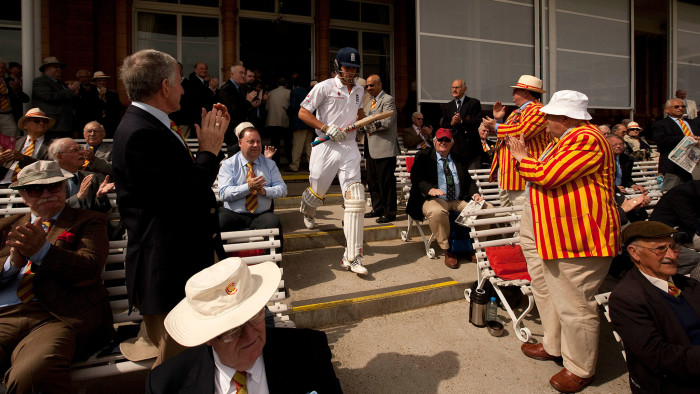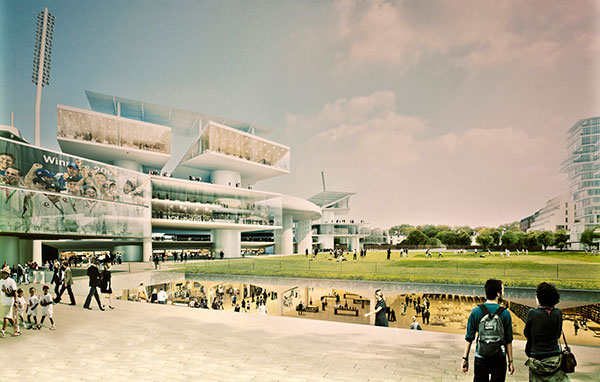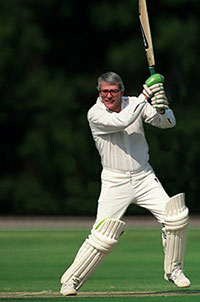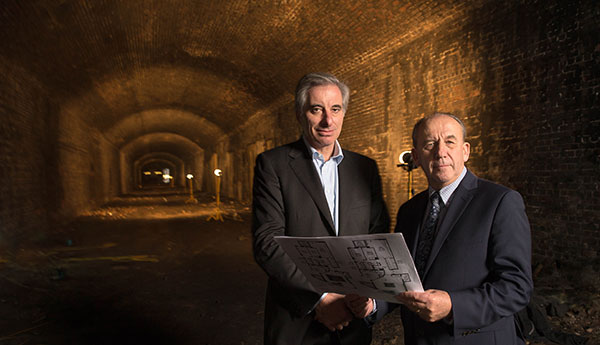The battle for Lord’s cricket ground

Roula Khalaf, Editor of the FT, selects her favourite stories in this weekly newsletter.
Of all Britain’s long-established institutions, perhaps none is as idiosyncratic as the 227-year-old Marylebone Cricket Club. It is a members’ club but not just any members’ club. The very initials MCC conjure the entire game: languid summer days and, for both better and worse, old-fashioned values.
As recently as the 1990s, MCC still, to an extent, retained its historic role of running cricket. Even now, having lost that empire, the club still writes the laws of the game, still has influence, and its home, Lord’s, is recognised as the world’s pre-eminent cricket ground. Not the biggest, not necessarily the best, partly because Lord’s (though its 17 acres are huge as a piece of prime London real estate) is quite cramped as a major sports venue. It is, however, where every cricketer, from the famous to the fantasist, wants to play and succeed – if only, in the case of uppity colonials, to put one over the snobby Poms.
Lord’s got its name simply because the ground was built, 200 years ago exactly, by one Thomas Lord. Before the war the president was indeed usually a viscount at least, and it likes to retain its lordly veneer. But for the past 15 years those with a sharp ear may have been able to detect a faint rumble, like the sound of a train in a tunnel deep underground. And that is exactly what the rumble is about: the ownership of three railway tunnels.
Most regulars at Lord’s have known little of this; even the club’s 18,000 members have been kept informed only patchily. Yet in the innermost sanctums of the pavilion, the affair has convulsed the club, driven a former prime minister off the committee and paralysed MCC’s long-term planning. It is an extraordinary story. From a distance, it might also be seen as a classically English sporting clash between tradition and money. But nothing in this affair is easily pigeonholed.
…
These tunnels convulsed Lord’s once before, far more publicly. In 1890 the company that became the Great Central Railway tried to acquire Lord’s so it could run its trains north out of Marylebone station. After a huge rumpus, the lines were built underground, beneath the Nursery, a real fruit and vegetable nursery before it became the practice ground where cricketers learnt and refined their skills. Everyone soon forgot the railway was there.
The Great Central was a flop from the start and, in 1966, fell victim to Dr Beeching’s axe. One tunnel remains in use for commuter trains; the other two became redundant and lay there until British Rail was privatised, whereupon the new owners, Railtrack, saw the chance to sell them and in 1999 offered Lord’s a long-term lease on its stretch.
MCC was cautious; you might say unbelievably stupid. It made only a halfhearted offer, so Railtrack opted for an auction, where the club was outbid by a property company, the Rifkind Levy Partnership, which secured a 999-year lease on a 38m strip of land running the length of Lord’s for £2.35m, and the right to develop the two disused tunnels. The Great Central was ambitious and built these tunnels on a gigantic scale: you could park an airship down there never mind run a train. Charles Rifkind, one of the partners, was also ambitious: he saw all kinds of possibilities above ground and below; MCC could not even see the importance of securing its own space.
Oliver Stocken, now MCC’s chairman, was then a new committee member. “You’ve got to go back to where we were in 1999,” he says. “The club didn’t have much money in those days. Of course we all regret not buying it. We stopped bidding at the extreme of what we thought we could afford at the time.” However, property in St John’s Wood was pricey even then and MCC did not seem impoverished.
“I saw it as a development opportunity for the benefit of cricket,” says Rifkind. “I saw what they hadn’t seen. I’ve lived in the area for 30 years. I’ve walked past it for 30 years. This was a natural asset, it was obvious.”
Time-honoured cricket etiquette insists that the umpire’s decision may not be disputed. However, it is perfectly possible to sulk against perceived injustice. To some in MCC, Rifkind’s motives for bidding against them could only have been nefarious. It was a very long sulk. For seven years, there was almost no contact. MCC’s lease above ground was secure but 18in below ground the land passed to Rifkind. He could not build on the strip; nor could they. MCC had and still has what it calls “the nursery pavilion”, a set of glorified marquees used for hospitality and events; the area behind remained a place for storing rubbish and parking the broadcasters’ trucks. The cricketers played on.
…

In 2006 Maurice de Rohan, chairman of the club’s estates committee and a visceral opponent of any dealings with Rifkind, died. Newer blood came on to the committee. There was also a sparky new MCC chief executive, Keith Bradshaw, an Australian without any institutional memory. He had lunch with Rifkind; they got on. What emerged three years later was “The Vision”, a radical £400m plan produced by another set of outsiders, the Basel-based architects Herzog & de Meuron, whose star project was the Beijing Olympic Stadium. The plan was driven by a new development subcommittee chaired by a zestful Welsh QC, Robert Griffiths, and including two former England captains plus one former prime minister, Sir John Major.

Visions have a habit of being unrealistic. This one was, perhaps, no exception. From doing nothing, MCC suddenly wanted to do everything: not just using the tunnels but also constructing a vast, open-sided “undercroft” beneath the Nursery ground, with cafés and walkways to give the place potential all-year use; at present Lord’s is well-filled only for about a dozen days a year of international cricket. The Vision also included a huge 17-lane indoor cricket school; the current one has eight. The capacity of the ground was to be increased by 5,000. All this was to be funded by building apartments on the land above the tunnels. The chosen development partner, Almacantar, offered a £100m payment to MCC for the right to build as soon as planning permission was given. It never got that far.
…
The Beijing Olympics offers an interesting analogy because, in certain respects, the MCC does resemble the People’s Republic of China. In many ways it is highly efficient and successful; and it is increasingly attentive to the needs of the party cadre and the peasantry. But its processes are opaque, and it could never be mistaken for a full democracy.
The president is selected annually by his predecessor. Just over half the club committee is elected by the members but the chairman is chosen by an obscure process of consultation. The cadre is the membership. In return for a very Chinese kind of patience, which in most cases now involves a 25-year wait, they are rewarded with automatic election to a highly privileged elite for just £466 a year. The members (average age 61, women included since 1999) are habitually docile unless those hard-won privileges are threatened, and there was not much for them in The Vision. Indeed, the flats would impinge on their view of the trees, which have a special place in Lord’s folklore. Sir George “Gubby” Allen, a former England captain and a great grey eminence of the place until he died in 1989, was adamant that it should always be a cricket ground not a stadium, and that the trees fringing the Nursery should remain visible from the much-loved main pavilion. As a result, the non-members’ area on the lower tier opposite is like a dungeon.
And, once Almacantar was appointed, the stars began to realign again. For a start, the global financial crisis had kicked in and for a while London property no longer looked a one-way bet. Secondly, cricket’s own economy was under threat with falling ticket sales for Test matches. Thirdly, three new Test match grounds – in County Durham, Cardiff and Southampton – had emerged as well as the six that traditionally staged all the big matches. The certainty that Lord’s would stage two Tests every summer was no longer guaranteed.
Most significantly, Oliver Stocken had just become chairman, and he is not a man for grand visions. Though barely known to the MCC members who never elected him, Stocken is an interesting and accomplished man. No cricketer (he rowed at Oxford), he was a merchant banker who later collected non-executive directorships and charity trusteeships with unusual voracity. One imagines him as that very useful type of non-exec who is always the last to be convinced by a new idea. This quality is not necessarily ideal in the chairman of a members’ club.
Supporters of The Vision insist there was no risk to MCC, and that the £100m from Almacantar would have secured the club’s prosperity for decades. But Stocken, in conjunction with a small group of allies in the mysterious upper reaches of MCC, scuppered The Vision. It happened, some say, without the plans being more than skimpily debated by the committee, never mind – heaven forfend – by the members. In doing so, Stocken saw off one opponent with some experience of political skulduggery. In 2011 Sir John Major resigned in fury from the MCC committee. Rifkind was shut out again.
Stocken had disbanded Griffiths’ development committee and set up a new working party that, in Major’s words, contained only opponents of The Vision. Though Major himself had come round to thinking the scheme should be scaled back and the undercroft abandoned, he accused the club in an open letter of “traducing and misrepresenting” him. Another member of the development committee, Lord Grabiner QC, described MCC decision-making at the club’s special meeting last year as “high-handed, undemocratic and secretive”. This meeting, however, backed Stocken: the postal vote saw to that.
“It really was a serious mistake that the executive was not sufficiently involved in the development committee,” says Stocken now. “The Vision had not addressed what the club needed. I said, ‘Can someone tell me why we need a 17-lane indoor school?’ and ‘Let’s see what we need as a cricket club.’ The plan wasn’t practical.”
“What he’s been able to do is stuff the whole thing,” according to Grabiner. “I think the whole exercise was designed to ensure the strip was never developed in any way that put money into Rifkind’s pocket.”
…

It is not just insiders who have been bewildered by MCC’s processes. The only access to Rifkind’s tunnels comes via the basement of MCC’s neighbour, Britain’s largest private hospital, the Wellington, which was very interested in using the tunnels, especially for cancer treatment – radiotherapy normally needs to be conducted in lead-lined rooms to prevent leaks. “Put them underground and the problem doesn’t exist,” says Keith Hague, who has just retired as the Wellington’s chief executive. He became exasperated by MCC. “Here was a developer saying, ‘Have £100m with no strings’, and I’m thinking, ‘Let’s get going’ and they said no. I couldn’t believe it.”
Over the past two years Stocken and the club’s new chief executive, Derek Brewer (who took over when Bradshaw, suffering from cancer, went back to Australia in 2011), have been working on “The Masterplan”. This involves rebuilding five of the seven stands round the main ground at £20m each from the club’s own resources. This will solve some essential problems, focusing entirely on “running a top-quality match” but will barely increase the capacity of the ground or transform the facilities. “It’s not a vision,” said Grabiner. “It’s lack of vision.”
Stocken is unbowed. High-handed? “You can’t keep a committee that meets six to eight times a year abreast of everything.” Talk to Rifkind? “Why would we want to talk to him? He’s the landlord. We pay the rent. What else do you need to do? We are not under pressure to do anything whatever. Maybe we can talk to him in another 10 years or so. Or to his son.”
But suddenly things are happening. For there is pressure: the temporary Nursery pavilion is likely to have its planning permission withdrawn before England hosts the 2019 World Cup, and Rifkind has invoked a clause restricting its use to cricketing purposes and not general hospitality or conferences, a direct hit on MCC revenue. Stocken, previously so cautious about the club’s resources, now appears to be saying there is no problem.
Earlier this month, the MCC committee agreed to hear a new presentation from another architect, David Morley, for a scaled down, post-Vision scheme that would include flats in the corners and a low-slung entrance-cum-nursery-pavilion in the middle. The trees should still be visible. A deal could give both MCC and the hospital use of the tunnels, and the £100m is being waved again, which would pay for the stands. Stocken’s opponents will be in full cry at the annual general meeting next month, demanding a fair hearing, not a stitch-up. But the rank-and-file seem more concerned about whether there will be enough legroom in the new Warner Stand.
However, Stocken, 72, retires next year. Rifkind, 56, has no plans to go anywhere. “You have to understand about Charles,” says one associate. “He doesn’t need the money. This has become a mission for him. And he’s never ever going to give up.”
Matthew Engel is an FT columnist and former editor of Wisden
——————————————-
Letter in response to this article:
Is sports reporting back in the game? / From Mr Mike Tyler
Comments